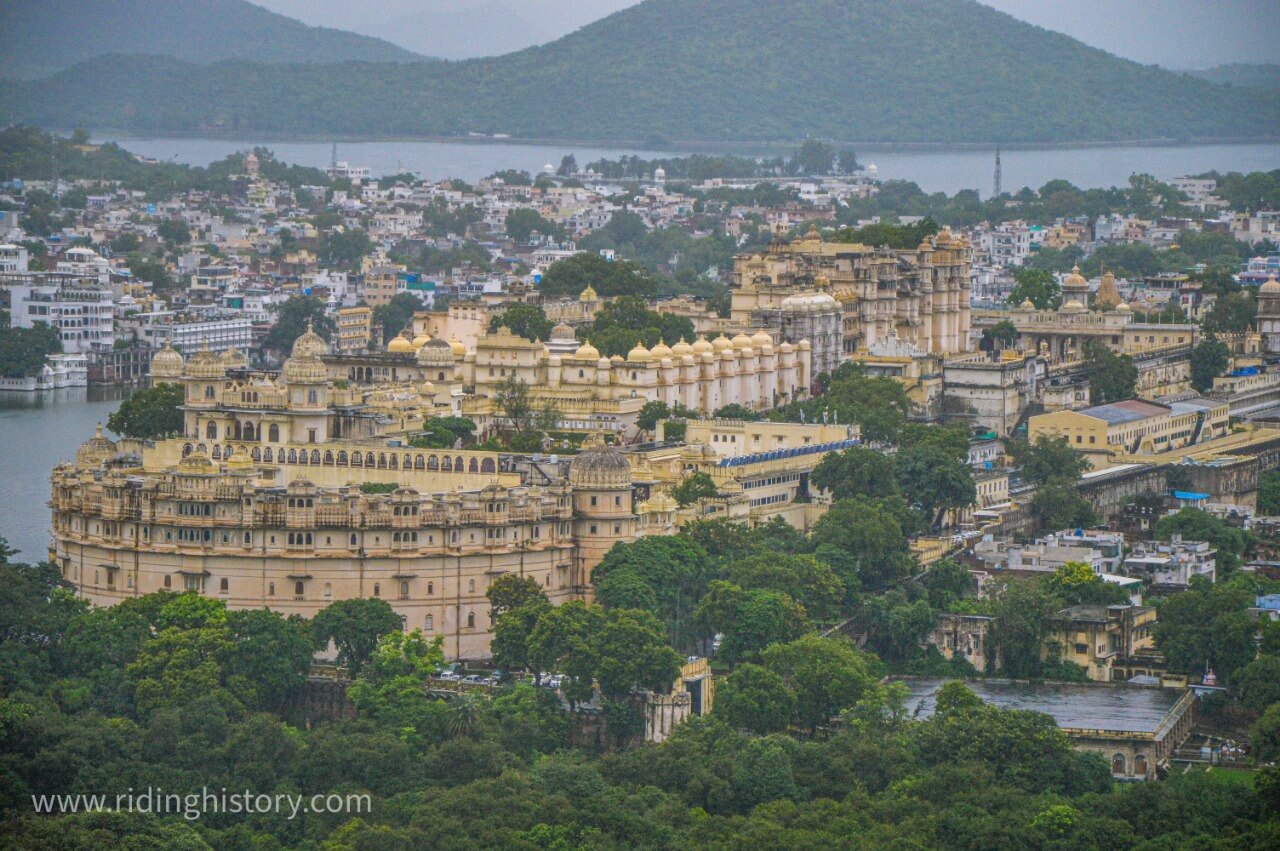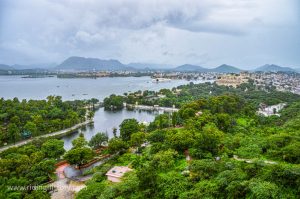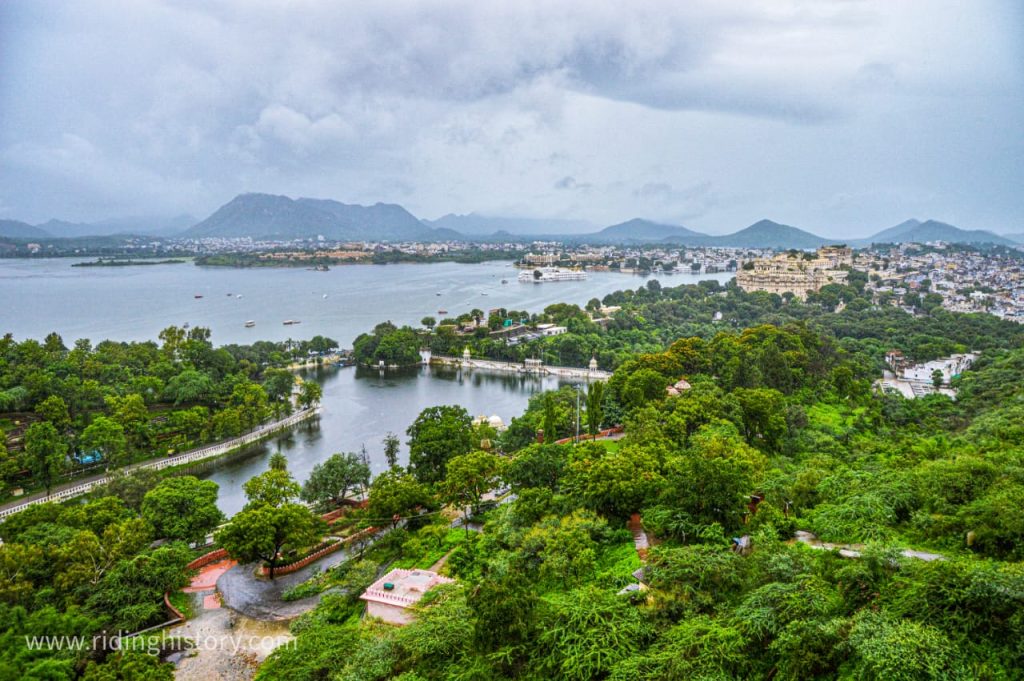40 Best Places to visit Udaipur 2024 | Udaipur Tourist Places 2024 | Udaipur Tourism | Things to do in Udaipur | Udaipur Travel Guide 2024 | Part – 04
History of Udaipur

Tourists visit this beautiful city throughout the year to see and know the historical backdrop of Udaipur’s royal family and the huge palaces, monuments and man-made lakes built in Udaipur. Udaipur city is so rich in a natural form that many scenic tourist places are present in the area of more than 100 square kilometres around it.
Some of these scenic tourist places are famous because of their natural feature and some are more famous due to their history and architecture. Due to being surrounded by the Aravalli ranges, many small and big rivers in the vicinity of Udaipur continue to support the region naturally throughout the year.
Due to these rivers, many man-made lakes have been constructed occasionally in the areas around Udaipur. If you are planning to visit Udaipur, then you must know about the historical background of Udaipur so that your visit to Udaipur will become even more memorable and exciting. The city of Udaipur, which was the capital of the Mewar region of Rajasthan, is witness to a very long struggle.
Ever since the creation of Udaipur, the kings who ruled this city had to struggle for a long time for the independence of Mewar. The name of Maharana Pratap is most taken in the struggle for freedom of Mewar. Most of the monuments that have been built in Udaipur have been built keeping in mind the struggle of Maharana Pratap and his freedom for Mewar.
Haldighati Udaipur
Haldighati is a very narrow mountain pass, situated in the dense forests of the Aravalli ranges. This mountain pass is known as Haldighati because of the colour of turmeric (yellow) found in Haldighati. Haldighati is a dense forest area situated between the villages of Khamnore and Bagicha. Haldighati to Udaipur is just 40 km away.
The fierce battle in 1576 between Maharana Pratap and Maharaja Sawai Mansingh I of Amer, who was then the commander of the Mughals, is the biggest reason behind Haldighati being a famous scenic spot. During the war in Haldighati, Maharana Pratap’s army faced the Mughal army five times larger than himself.
The Mughal army suffered huge losses in the Battle of Haldighati, due to which they had to retreat from the battlefield—during the battle of Haldighati, Chetak, the beloved horse of Maharana Pratap, laid down his life while protecting Maharana Pratap. Later, an umbrella (Samadhi) was built near Haldighati in honour of Chetak, the loyal horse of Maharana Pratap.
The battle of Haldighati had lasted only for four hours, but even in such a short time, the land of Khamnore village near Haldighati had turned red with blood. The place where the war took place in Khamnore village is currently known as Rakhtalai. Bagicha village near Haldighati is very famous for Gulakanda made from rose flowers. Bagicha village is also famous for its articles made of clay apart from Gulkand.
Maharana Pratap Museum Haldighati Udaipur
The Maharana Pratap Museum near Haldighati was built in 2003 by Mohan Srimali, a resident of Balicha village near Haldighati. The Maharana Pratap Museum has become very popular with tourists since its construction.
Every year millions of native and foreign tourists come to Haldighati to visit Maharana Pratap Museum. The main reason behind the construction of this museum was to make the tourists visiting Haldighati aware of the struggle for freedom of Mewar by Maharana Pratap.
The Maharana Pratap Museum depicts important events related to the Battle of Haldighati and the life of Maharana Pratap using 3D animation film and Light and Sound effects in a very effective way. Apart from this, the living and daily routine of the people of that time has been elaborated in the museum.
Maharana Pratap Museum Haldighati Udaipur Timings
Maharana Pratap Museum is open all week from 08:00 AM to 06:00 PM.
Maharana Pratap Museum Haldighati Udaipur Entry Fee
Indian tourists are charged an entry fee of Rs 100 / – to the museum and the entrance fee for children is Rs 50 / -. An entry fee of Rs 200 / – is charged from foreign tourists.
Sajjangarh Biological Park Udaipur
The Sajjangarh Biological Park located near the Monsoon Palace was inaugurated on 12 April 2015. The main reason for the construction of Sajjangarh Biological Park is to provide natural habitat to the wildlife living in Gulab Bagh Zoo located in the central part of the city.
This biological garden is spread over an area of about 36 acres. The vegetation of Sajjangarh Biological Park is extremely dense due to its location in the Aravalli ranges. Sajjangarh Biological Park is home to wildlife like a wild cat, tiger, leopard, sambar, striped hyena, fox, Himalayan black bear, lion, chital, jackal, white tiger, star turtle, crocodile and crocodile.
Due to the Biological Park being spread over a large area, the park also offers golf carts and bicycles for tourists. There is a canteen in the garden for eating and drinking. Sajjangarh Biological Park is closed to tourists on Tuesday.
Sajjangarh Biological Park Udaipur Timings
Except for Tuesday, Sajjangarh Biological Park is open for tourists from 10:00 am to 06:00 pm for the rest of the week.
Sajjangarh Biological Park Udaipur Entry Fee
The entrance fee to the park is charged Rs 30 / – for Indian tourists and Rs 15 / – is charged from the students. The entry fee for foreign tourists has been fixed at Rs 300 / -. Apart from the entrance fee, the fee for facilities available in Sajjangarh Biological Park is as follows:
01 Golf Cart – 50 / – INR
02 Electric Car – INR 50 / –
03 Camera – 80 / – INR
04 Video Camera – 200 / – INR
Wax Museum Udaipur
The wax museum located in Udaipur was inaugurated by Yuvraj Lakshraj Singh Mewar of Udaipur in 2016. The Wax Museum in Udaipur is the fifth wax museum of its kind in India. The Wax Museum of Udaipur is considered to be an exact copy of the famous wax museum of England, Madame Tussauds.
The wax museum was built to promote the growing trend of wax museums in the world and to promote tourism in Udaipur. Apart from the residents, native and foreign tourists come all year to see the wax museum located in Udaipur. The Udaipur Wax Museum has a collection of wax sculptures of 15 great and eminent persons from the country and abroad.
Among the prominent persons of India in the museum, a wax statue of Sachin Tendulkar, Lakshya Raj Singh Mewar, Kalpana Chawla, APJ Abdul Kalam, Panna Dhai, Maharana Pratap and Meera Bai, besides the Prime Minister of India, has been installed.
The museum also has wax statues of some of the world’s most famous personalities such as Barack Obama, Harry Potter, Jackie Chan, Bruce Lee, Bruce Willis and Arnold. All the sculptures located in the museum have been sourced from London and the management paid a huge amount for the maintenance. In the Wax Museum of Udaipur, tourists can enjoy horror shows, a mirror maze and a 9D cinema in addition to wax sculptures for their entertainment.
Wax Museum Udaipur Timings
From 09:00 in the morning to 09:00 at night.
Wax Museum Udaipur Entry Fee
The entrance fee for the wax museum has been set at INR 150 / – for tourists. Fees for other activities in the museum are as follows –
01 9D Cinema – 150 / – INR
02 horror show – 100 / – INR
03 Mirror Maze – INR 80 / -INR
Sahastra Bahu Temple Udaipur
Nagda village, 22 km from Udaipur, has an ancient temple of Lord Vishnu built around the tenth century. This temple dedicated to Lord Vishnu is famous as Sahastra Bahu Temple, apart from this the temple is also known as Saas Bahu Temple. In addition to the temple of Lord Vishnu in the Sahastra Bahu temple, a total of 18 ancient temples were built.
In these 18 temples, besides the temples of Lord Shiva, Lord Brahma and Mother Saraswati, there are also temples of several major gods and goddesses of Hinduism. The main reason behind calling this temple Sahasra Bahu Temple is the statue of Lord Vishnu installed in the main temple with multiple arms, hence this temple is called Sahasra Bahu Temple.
The Sahastra Bahu temple, built in the tenth century, is more famous among the local people than the Saas Bahu temple. As time passed after the construction of the temple, the name of Sahastra Bahu temple in the local people became smaller, and the name of this temple became Saas Bahu Mandir, local people. The size of the Sahastra Bahu temple is 32 meters long and 22 meters wide.
There are three entrances in the Sahastra Bahu temple, each of which has statues of Lord Vishnu, Lord Brahma and Mother Saraswati installed respectively. In the construction of the temple, the temple has very fine carvings made on the walls and pillars by the artisans. The walls of the temple have sculpted statues of major deities of Hinduism, due to which the temple look grander.
The Sahastra Bahu temple was built by Maharaja Mahipal, the ruler of the Kachhwaha dynasty in Nagda, for his queen. Maharaja Mahipala’s queen was an ardent devotee of Lord Vishnu, due to her queen’s deep faith in Lord Vishnu, the king built the Sahastra Bahu temple in Nagda.
Some historians believe that Bappa Rawal built the Sahastra Bahu temple. Around the 16th century, the Sahastra Bahu temple was invaded by Mughal invaders destroyed most of the temples built in the temple complex. The invaders had destroyed all the idols of the deities built on the walls and pillars of the temple. At present, all the temples located in the Sahastra Bahu temple complex stand fragmented.
Sahstrabahu Temple Udaipur Timings
Tourists can visit the Sahastra Bahu temple from 05:00 am to 12:00 noon, and from 04:00 pm to 09:00 pm.
Sahstrabahu Temple Udaipur Entry Fee
Free.
Ahar Archaeological Museum Udaipur
About 19 kings of the Sisodia Rajput family of Mewar were cremated at a place called Ahar, about three kilometres from Udaipur city. Cenotaphs were built at this place in honour of all the kings who went to the last rites of this place.
Marble stone has been used in the construction of all the Cenotaphs built in honour of the kings of the Sisodia Rajput family in Ahar. To give beauty to the umbrellas, columns and huts have been specially carved by artisans. Cenotaphs were constructed from time to time in honour of kings such as Maharana Amar Singh, Maharana Swaroop Singh, Maharana Shambhu Singh, Maharana Fateh Singh, Maharana Bhupal Singh, Maharana Sajjan Singh.
The last chhatri was built in 2004 after the funeral of Maharana Bhagwat Singh. The Archaeological Department of India established the Ahar Museum in 1961–1962, near the Cenotaphs of the Kings. The State Ahar Museum exhibits household materials used before 1700 BC and the 10th century, mainly displaying red-coloured vessels, spouted lotus, pans, lamps and horns of different animals.
Antiquities associated with the Ayad civilization are exhibited in the museum 4000 years ago. The museum also has a collection of many ancient idols associated with Lord Shiva, Vaishnavism and Jainism. Among all the statues located in the museum, the 8th-century statue of Jain Tirthankara made of Ashtadhatu and the stone sculptures in the Stone Age are the main centres of tourist attraction.
All the antiques located in the museum have been obtained during excavation from the vicinity of Udaipur. Ahar is also known as Dhulkot Dhora, in ancient times Ahar was called Aghatpur. Tourists are not charged any entry fee for entering the canopy located in the Ahar.
Ahar Archaeological Museum Udaipur Timings
Ahad Museum is open to tourists on all days of the week except national holidays and Fridays. The museum is open for tourists from 10:00 am to 04:30 pm.
Ahar Archaeological Museum Udaipur Entry Fee
No entry fee is charged for tourists to enter the Chhatris located in Ahad.
An entry fee of INR 30/- per person is charged for tourists at the Government Ahad Museum.
Menar Lake Udaipur
Menar is a small village located 52 kilometres from Udaipur. Due to Menar Lake being located in this village, there is a gathering of migratory birds in this village during the winter season. The village of Menar near Udaipur is considered to be the first choice of birdwatchers, bird lovers and wildlife photographers due to migratory birds arriving during the winter season.
In tourism, Menar village is also known as Bird Village. Birds that migrate to Lake Menar include red-walled lapwing, northern pintail, bar-headed goose, little ringed plover, green sandpiper, greater flamingo, black kite, common crane, northern shovel, white-tailed lapwing, wood sandpiper, marsh Migratory birds such as harriers and pelicans can be seen.
The 52-foot-high statue dedicated to Lord Shiva in the temple of Thakurji in Menar village is also a major attraction for tourists visiting Menar. The villagers of Menar village are also fully aware of the migratory birds that come here. There is no lack of water in the lake, so the water of the lake is not used in any way by the people of the village, the hunting of fish living in the lake is also completely banned.
The cleanliness of Menar Lake is also given full attention by the villagers.
Mewar Festival Udaipur
The spring season is welcomed in different ways in every state of India. The Mewar festival celebrated during the spring season by the royal family of Udaipur holds special significance for the local public of Udaipur and tourists visiting Udaipur. The Mewar festival held every year in Udaipur is celebrated with Gangaur, the famous traditional festival of Rajasthan.
At this time all the markets of Udaipur are beautifully decorated. Mewar festival celebrated in Udaipur is dedicated to women, so local women celebrate Mewar festival with great enthusiasm. In the Mewar festival celebrated at the time of Gangaur, women take out the tableaux all over the city by decorating the idols of Rajasthan’s folk god Isar (Lord Shiva) and Gangaur (Mata Parvati).
To immerse the tableau of Isar and Gangaur in the Pichola Lake, the locals of Udaipur take out a huge traditional procession. In this procession, the idols of Isar and Gangaur are beautifully decorated with traditional costumes and the locals go to the banks of Lake Pichola to dance and sing.
After that with the help of a boat, the idols of Isar and Gangaur are taken to the central part of Lake Pichola and immersed respectfully in the water. After the immersion of the idols of Isar and Gangaur, a nightly cultural program of the Mewar festival is organized. Nightly cultural programs are performed with songs and dances performed by indigenous and foreign artists.
Spectacular fireworks are performed at the concluding program of the Mewar festival. Domestic and foreign tourists like to see the Mewar festival organized in Udaipur every year. The three-day Mewar festival held in Udaipur is held in March of the year.
Mewar Festival Udaipur Timing
The three-day Mewar festival held in Udaipur is held in March every year.
Mewar Festival Udaipur Ticket Price
Fees determined by the organizers are payable.
Kumbhalgarh Annual Festival Udaipur
The world-famous Kumbhalgarh Fort has located about 85 km from the city of Udaipur and in the middle of the dense hills of the Aravalli ranges. In this fort, Kumbhalgarh annual festival is organized every year in the last week of November or in the first week of December. Maharana Kumbha built the Kumbhalgarh Fort, after the construction of the fort, he also built many temples and monuments in the vicinity of the fort.
Maharana Kumbha was also very good at music and art, and during his reign, arts and culture were also greatly encouraged. The Rajasthan Tourism Department organizes the annual festival of Kumbhalgarh in Kumbhalgarh Fort every year in his honour due to the contribution made by Maharana Kumbha to art and culture. The annual festival held at Kumbhalgarh Fort is of three days duration.
During the three-day program in the festival, different programs related to folk music, folk dance and classical music are presented by native and foreign artists. The folk music programs in the fort are so spectacular that even the spectators watching the program are forced to dance.
Kumbhalgarh Fort is decorated in a very beautiful way during the program lasting three days. And seeing the fort bathed in colourful lights at night offers a different experience in itself. During the Kumbhalgarh annual festival, handicrafts, traditional costumes, traditional ornaments and souvenirs are kept hanging in the premises of the fort during the day time.
Light and sound shows, folk dances and folk music shows are organized for visitors and tourists visiting the fort at night. Several interesting competitions are organized in the festival among the local residents and foreign guests such as musical chairs, turban tying competition and entertaining events such as tug of war.
If you are going to visit Kumbhalgarh during the annual Kumbhalgarh festival, then you must see the puppet show in addition to all the events organized here.
Tourist places near Udaipur
There are many beautiful tourist places around Udaipur like City Palce, Udaipur Part-01, Udaipur Part-02, Udaipur Part-03, Kumbhalgarh, Kumbhalgarh National Park, Jodhpur, Ranakpur, Parshuram Mahadev Temple in Saadri, Chittorgarh, Nathdwara, Mountabu and Amba ji Temple located in Gujarat.
(If you have reached here in this article, then I have a small request from you to share your suggestions related to this article in the comment box below, and if you see any deficiency or any wrong information, then also Tell. I keep posting information related to my travel on this website, if you like the information given by me, then you must subscribe to my website through your email, thank you)



